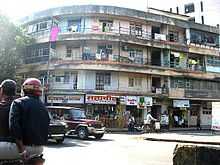Chawl


A chawl (from Marathi चाळ, chāḷ) is a name for a type of building found in India. They are often 4 to 5 stories with about 10 to 20 tenements, referred to as kholis, which literally mean 'rooms' on each floor. Many chawls can be found in Mumbai where they were constructed in abundance in the early 1900s to house the people migrating to Mumbai because of its booming cotton mills and overall strong economy.
A usual tenement in a chawl consists of one all purpose room, that functions both as a living and sleeping space, and a kitchen that also serves as a dining room. A frequent practice is for the kitchen to also serve as a bedroom for a newly married couple, to give them some degree of privacy. Average rents run about Rs. 1,000, equivalent to about 16 USD per month.
Families on a floor have to share a common block of latrines, each block containing typically 4 to 5 latrines. Tenements with private bathrooms are highly sought after and may cost a premium. Typically they may be available for 50% over the price of a normal chawl.
People living in a chawl have little privacy. Due to the close nature of the quarters, trivial news and gossip travels quickly. On the other hand, however, this intimate living situation also leads to a friendly atmosphere, with support networks akin to familial relationships.
A Chawl life is quite contradictory to what you see in today's world especially the fact that people are secluded in behavior unlike a chawl. A chawl stimulates interaction among communities, and there is a bridged gap between rich and poor. In today's era a chawl is occupied by several middle-class people including people from different parts of the country. Although there is such a big difference in culture and religious and ethnic backgrounds, people in chawl have still maintained healthy relationships and it is less likely to have disputes between communities. Hence you could find Christians, Hindus, Muslims, Jains, Parsis, etc., all living under the same roof.
The architectural similarity between all chawls are their balcony structures- these were created so that people could come out of their houses and interact with each other. The balconies form common grounds for people to mingle.
Chawls have a unique heritage value. They are good examples that show how peaceful different communities can live with each other. Not only that, neighbours get to learn each other's tradition and cultures and it exposes much learning into religions and beliefs.
In popular culture
The distinctive cultural features that arise from this unique situation have been featured in plays, novels like Q&A by Vikas Swarup (source of Slumdog Millionaire) and films like Katha (1983), a Hindi comedy movie directed by Sai Paranjpye.[1] In the films Vaastav, Bunty aur Bubli and D, the heroes begin their lives in chawls. In the Zee TV soap opera Pavitra Rishta one of the main character's family lives in a chawl.In the Colors (TV channel) soap opera Madhubala-Ek Ishq Ek Junoon female protagonist family lives in a chawl. In Mulk Raj Anand's novel "Coolie" the central character Munoo lives with two family groups in one chawl in his time in Bombay; there are detailed descriptions of such living circumstances.
References
Further Reading
Karandikar, Priyanka (2010). Chawls: Analysis of a middle class housing type in Mumbai, India (MS thesis). Iowa State University. Retrieved 31 January 2013.
External links
| Wikimedia Commons has media related to Chawl. |
- Times of India Life in a chawl. February 6, 2011.
- Slate (magazine)/Quora What Is It Like to Live in a Chawl? First person description of growing up in a chawl. June 25, 2013.